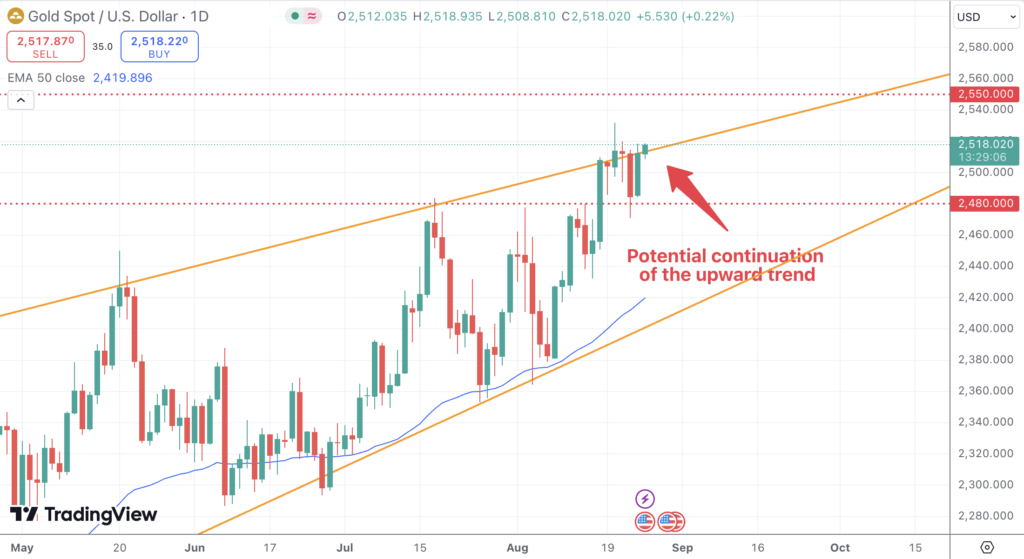Key Takeaways
- Gold has maintained its position above $2,500, with bullish momentum supported by geopolitical tensions and dovish Fed expectations.
- Technically, gold has broken out of a symmetrical triangle, with resistance at $2,550 and $2,600, and support around $2,480 and $2,467.
- The Federal Reserve’s potential rate cut in September, alongside moderating inflation, has provided a favorable environment for gold.
- Geopolitical risks, particularly in the Middle East, continue to bolster gold’s appeal as a safe-haven asset, with the Jackson Hole symposium being a key event to watch in the coming week.
Market Dynamics and Recent Performance
Over the past week, the gold market has experienced a combination of upward momentum and periods of consolidation. The price of gold (XAU/USD) has consistently traded above the $2,500 mark, buoyed by a range of factors including geopolitical tensions and shifting expectations surrounding U.S. monetary policy. As the market edges closer to the Jackson Hole symposium, investors remain cautious yet optimistic, as the event is expected to provide critical insights into the Federal Reserve’s next steps.
Despite periods of sideways movement, gold has managed to maintain its position near record highs. The market’s resilience has been underpinned by ongoing concerns about the global economic outlook and geopolitical risks, particularly in the Middle East. The situation has led to sustained demand for gold as a safe-haven asset, reinforcing its upward trajectory even as traders remain wary of potential pullbacks.
Technical and Fundamental Influences
From a technical standpoint, gold is currently exhibiting strong bullish characteristics. The metal has broken out of a symmetrical triangle formation, signaling a potential continuation of the upward trend. Key resistance levels have been identified at $2,550 and $2,600, with the possibility of reaching new highs if these levels are breached. Support levels are seen around $2,480 and $2,467, which could be tested if the market faces any short-term corrections.

Fundamentally, the outlook for gold remains positive, driven by a combination of factors. The Federal Reserve’s recent hints at a possible rate cut in September have fueled expectations of a more accommodative monetary policy. This dovish stance has been further supported by recent inflation data, which showed signs of easing pressures. The Producer Price Index (PPI) and Consumer Price Index (CPI) both indicated that inflation is moderating, providing the Fed with more room to maneuver in terms of rate adjustments.
Additionally, the ongoing geopolitical tensions, particularly the conflict between Israel and Hamas, have continued to support gold prices. The potential for further escalation in the region has heightened market uncertainty, leading investors to seek refuge in gold. This geopolitical backdrop, combined with the expectations of a dovish Fed, has created a favorable environment for gold, pushing it closer to new record highs.
Looking Forward
As the market moves into the coming week, the focus will largely be on the Jackson Hole symposium. Fed Chair Jerome Powell’s remarks are expected to be a key driver of market sentiment, as investors look for clues on the central bank’s policy direction. Should Powell signal a clear commitment to easing monetary policy, it could provide further impetus for gold to continue its upward march. However, any indications of a more hawkish stance could introduce volatility and potentially stall the metal’s progress.
Geopolitical developments will also play a crucial role in shaping gold’s trajectory. The situation in the Middle East remains a significant source of uncertainty, and any further escalation could lead to increased demand for gold as a safe-haven asset. On the other hand, a de-escalation of tensions might lead to a short-term correction, testing the support levels mentioned earlier.

